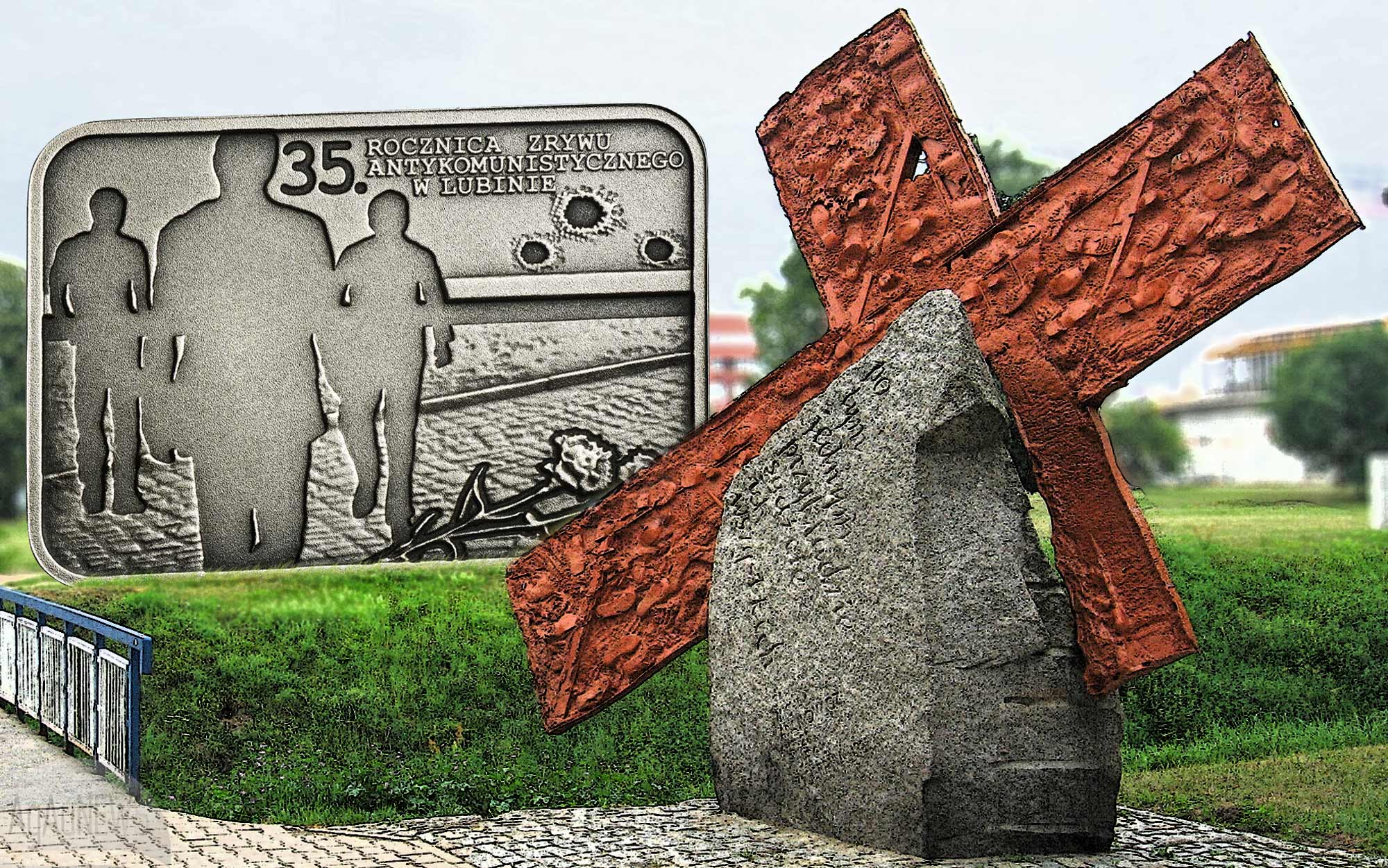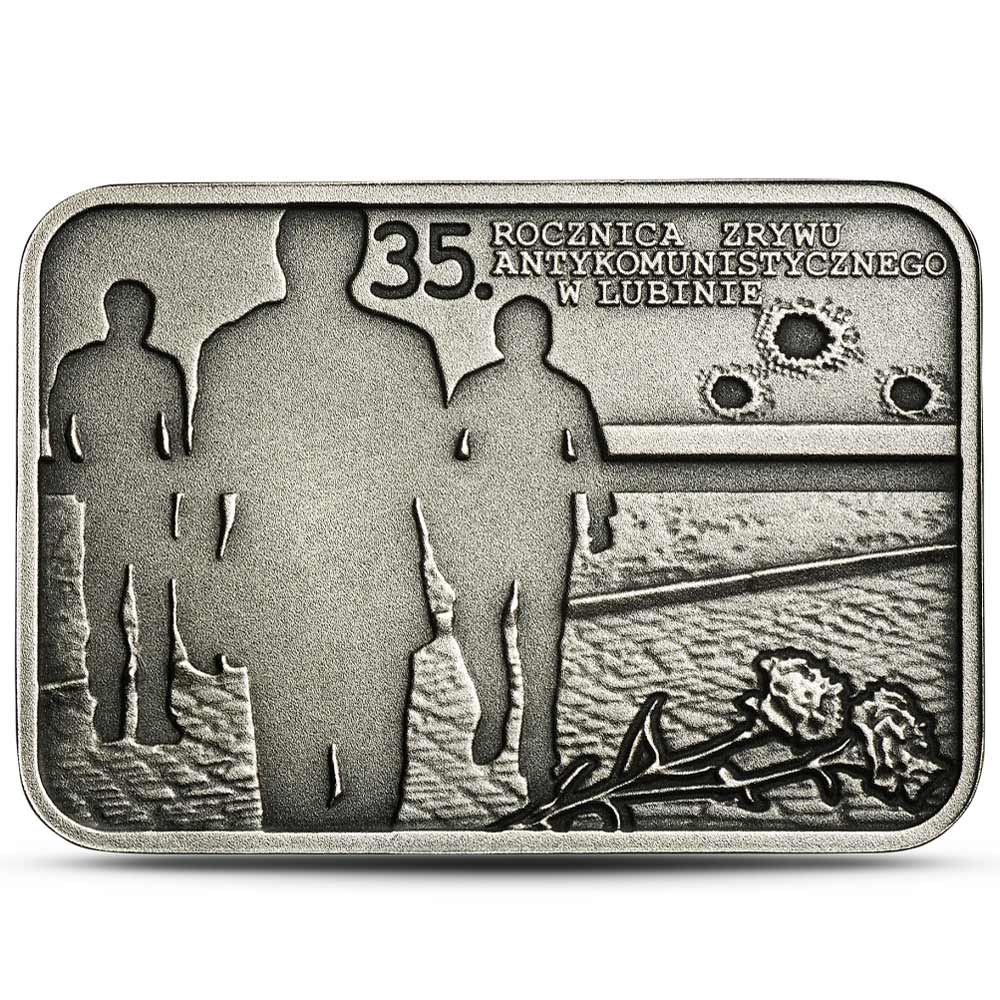Poland remembers the fallen of the 1982 anti-communist uprising in Lubin with new silver coin
The National Bank of Poland continues to commemorate Polands tumultuous post-war history with a coin remembering the anti-communist uprisings of 35 years ago. Part of a wave of protests and demonstarations around the freedom movement Solidarity, Lubin wasn’t a particularly large example, but the response of the government forces made it stand out regardless. The mint itself provides a fine summary of events that we’ve reproduced below.
The coin itself is a relative rarity for those issued by the NBP. While the colour on this coin is minimal, its presence is uncommon in itself, which along with the rectangular shape means this one is a little outside of the norm for the bank. The design ethos is typical, however. Very much in the same ilk as the recent Wola & Ochota massacre coin, the use of silhouette to represent the three people killed in the governments response to the demonstration is both effective and poignant.
Colour is used sparingly and just as a sash to represent the Polish flag – forming a path to the striking Polish eagle emblem. The reverse face is particularly well done. The three silhouettes are now incused, giving them an almost ghostly look. Three bullet holes and a pair of carnation flowers make the subject of the coin quite obvious and also quite powerful. We think it’s a very effective piece of design, enhanced by the antique finish and a fitting remembrance of the event and of the three fallen demonstrators.
Packaging is one of the neat little grey boxes that the mint uses for almost all of its output and the mintage is set at up to 15,000 coins. Available from 28 August, this is fine release and should sell for around the €60.00 mark.
MINTS DESCRIPTION
As far back as the 1950s, Lubin and its environs were the least developed and populated part of Lower Silesia. The region was modernized, however, afer the discovery of copper deposits in the area and the establishment of the Copper Mining and Metallurgical Complex, which funded many infrastructural activities. Residential estates, streets, schools and commercial establishments were built in Lubin. The Communist government was convinced that as it was a model city of that political system, the people of Lubin were also thinking along the accepted lines. All the more so, since the activities of the Solidarity movement in the Copper Basin between 1980 and 1981 did not indicate that the biggest centre of social resistance in this part of Poland, except for Wrocław, would be located here.
However, the scale of the strikes after the introduction of martial law, as well as the determination of the workforces of the mines and the “Głogów” copper works, showed that this region would not be socially passive. Following the pacifcation of the “Rudna” mine in the early days of martial law and the acts of the planting of small explosives, which were unheard of outside this region, the authorities feared that unrest could erupt here on 31 August 1982 on the 2nd anniversary of the August Agreements.
Indeed, demonstrations swept across all the cities of the Copper Basin. This was also the case in Lubin, although it wasn’t the largest demonstration. The demonstrators chanted the slogans of “Free the internees” and “Lif martial law”. The manifestation was initiated by the Solidarity activist Stanisław Śnieg. He delivered a speech in which he called for the release of all persons imprisoned for political reasons.
The intervention aimed at dispersing the demonstrators was carried out by the Citizens’ Militia (Milicja Obywatelska) and the units of the riot police – ZOMO (Zmotoryzowane Odwody Milicji Obywatelskiej). In the frst phase of the riots they fred chemical agents at the demonstrators, and subsequently used frearms with live ammunition. The reasons for these developments still have not been explained. Over twenty people were wounded, including seven seriously. Three people were killed: Andrzej Trajkowski, Mieczysław Poźniak and Michał Adamowicz.
The unrest continued in Lubin for 48 hours – 15,000 residents demonstrated on 1 September, and almost 5,000 people demonstrated the following day. There were riots and unrest. In order to stem the rising tide On 28 August 2017 Narodowy Bank Polski is putting into circulation a silver collector coin “35th Anniversary of the Anti-communist Uprising in Lubin” with a face value of 20 złoty. of protest, more than 1,000 uniformed ofcers were brought from outside the voivodeship, and the city of Lubin itself was isolated from the rest of the country for seven days.
Until the present day, not all the perpetrators of this massacre have been punished. The events in Lubin are symbolically represented in a photograph by Krzysztof Raczkowiak, which depicts the dying Michał Adamowicz carried by a group of men. The photograph is a silent witness to those events. The obverse of the coin depicts a red and white sash against the background of the silhouettes of three men, symbolizing the victims of the events in Lubin. On the reverse of the coin we see the outlines of three male fgures, next to whom there are three symbolic bullet marks, a sash and two carnations lying on the pavement.
Marek Zawadka, PhD
SPECIFICATION
| NAME | 2017 35TH ANNIVERSARY OF LUBIN UPRISING |
| DENOMINATION | 20 Zloty |
| COMPOSITION | 0.925 silver |
| WEIGHT | 28.28 grams |
| DIAMETER | 40.0 x 28.0 mm |
| FINISH | Antique |
| MODIFICATIONS | Selective colour |
| MINTAGE | 15,000 |
| BOX / COA | Yes / Yes |





Leave A Comment